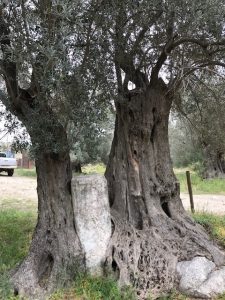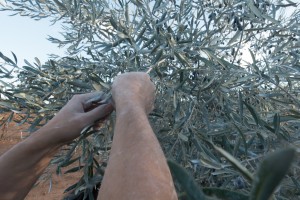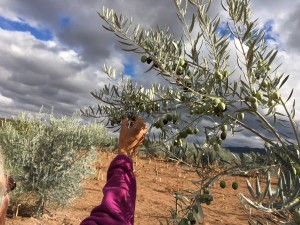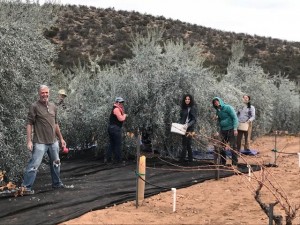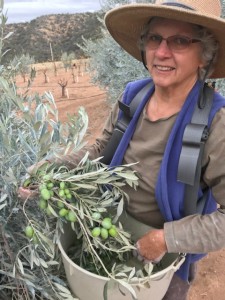We are looking forward to a fantastic olive harvest this year. So we thought it was a good time to honor this amazing fruit. The olive tree is the oldest cultivated tree, so its cultural history is rich. Dry-farming olives in the arid regions of the Middle East, Northern Africa and southern Europe has been part of this long tradition. Our 150 olive trees are part of our 5 acre dry-farmed vineyard. (Be aware: California agriculture is now planting large plantations of intensive, mechanized, water demanding olives where the trees are being grown in a dense hedge and will at most be kept in the ground for 25 years.) We have seen trees in Greece that have been harvested for over 1000 years.
Did you ever wonder how early cultures figured out the usefulness of the oil from a food source to a machine oil? If you taste one from the tree, you would quickly spit it out due to its bitterness. We are often asked what the difference is between green and black olives. As an olive ripens it turns from green to purple to black. Oil from ripe green olives is higher in antioxidants and will have a more bitter, grassy taste. We like to harvest when most of the olives on a tree are turning from green to purple. Oil from very ripe black olives has a more buttery taste.
Extra virgin is the highest grade of olive oil. The chemical characteristics of extra virgin olive oil (as with all vegetable oils) give an indication of the care with which it was made and stored: how the fruit was grown, transported and harvested, how it was milled into oil, and how the oil was packaged and bottled. The chemical standards for extra virgin olive oil are the highest of all the grades and, as such, offer a specific guarantee of quality.
Extra virgin olive oils can be anything from very delicate and mellow to quite bitter and pungent. Their anti-oxidant content varies considerably. With Condor’s Hope oil, we are looking for the grassy, slightly pungent taste that adds that extra zing when you pour it onto a hot soup, over vegetables, in a salad dressing or dipped with bread.
What are the components that make adding olive oil to your daily diet such a smart idea? So far, medical research has focused on three core areas of nutritional value.
- Olive oil is mainly comprised of monounsaturated fatty acids. A healthier type of fat, it reduces total and low-density lipoprotein (LDL or “bad”) cholesterol levels in the bloodstream, while raising high-density lipoprotein (HDL or “good”) cholesterol levels.
- High quality extra virgin olive oil, in particular, provides a high content of antioxidants, like polyphenols, vitamins E & K, chlorophyll and carotenoids. Antioxidants are key to strengthening the immune system and protecting the body from the damaging effects of free-radical molecules.
- Olive oil contains anti-inflammatory agents, like oleocanthal, that act as a natural ibuprofen-like substance.
Olive Oil Storage and Use Tips
Light and heat are detrimental to olive oil. So keep your oil in a dark, cool place, away from the stove. Dark glass protects the oil from light, including halogen and fluorescent lights.
Olive oil changes over time, losing its pungent character and becoming more buttery. Unlike wine, it is recommended that you use it within a year of its harvest. Enjoy!
Reference: https://www.oliveoilsource.com

